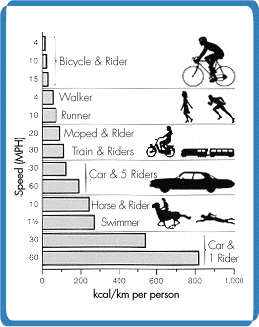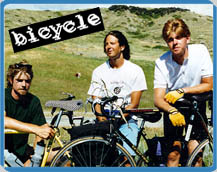|

|

The bicycle is a tremendously efficient means of transportation.
In fact cycling is more efficient than any other method of travel--including
walking! The one billion bicycles in the world are a testament to its effectiveness.
The engine for this efficient mode of transport is the human body. Because
bodies are fueled by food, diet plays an important role in how the body
performs. Different muscle groups and types provide the power. Genetic inheritance,
intensive training, and a competitive drive help top athletes push the boundaries
of endurance and speed on the bicycle.
How Far Do You Want To Go?
It takes less energy to bicycle one mile than it takes
to walk a mile. In fact, a bicycle can be up to 5 times more efficient than
walking. If we compare the amount of calories burned in bicycling to the
number of calories an automobile burns, the difference is astounding. One
hundred calories can power a cyclist for three miles, but it would only
power a car 280 feet (85 meters)!
|

|
A comparison of the energy cost of various forms of transportation shows
that the bicycle is most energy-efficient.
|
|
|

|
Bicycle
is "a band that rolls across the
country on bicycles and rocks in towns and cities along the way."
Bicycle has been touring the for the last few years. Using special lightweight
guitars and a pared-down drum kit, the band hauls their own equipment in
bike trailers. On one tour the band covered 200 miles (321 km) in 2 days.
"Heavy metal folk rap" is how the
New York Times
coined
the band's sound. You can hear for yourself by clicking on the RealAudio
Sound below. You can also visit the band's Web page (available in the "References"
section at the bottom of this page) for more information.
ColorFreak
3:13 Minutes RealAudio
(Depending on your connection, the
clip will be either mono or stereo)
|
|
|
Bike Culture
In the United States many people still consider cycling
only a recreation or professional sport. But millions of Americans have
found that cycling is a great way to get work or get around town. Some cyclists
are banding together and forming organizations and events advocating issues
important to cyclists.
|
|
The bicycle has had a great impact on popular culture as
well. In fashion, the bicycle was largely responsible for changing women's
clothing in the late 1800s. Restrictive corsets and long dresses made way
for bloomers and later trousers.
|
|
In the art world, the bicycle has made its way into painting
and sculpture. Most notably in Marcel Duchamp's
Roue de Bicyclette
or
Bicycle Wheel
which is considered the first 'readymade' sculpture.
|

|
Duchamp's
Roue de Bicyclette
, the 1951 version. The original, created
in 1913, has been lost.
|
|
|
|
Fuel for Thought
Unlike automobiles, which require fossil fuel, cyclists
are fueled by food, a renewable energy resource. The type of food a cyclist
eats can affect perfomance. All of us require water, protein, carbohydrates,
fats, vitamins, and minerals to stay healthy. For top atheletes, maintaining
a proper balance of these nuturients is extrememly important. U.S. Women's
cross-country champion Ruthie Matthes explained, "Off the bike I tend
to eat a lot of vegetables and fruits, high carbohydrates--but not to the
extreme of where I'm eating just rice and potatoes. I do mix protein in."
During races many cyclists will use high-carbohydrate drinks, bars, or even
gels for instant energy.
|

|
|
Fluids
The human body is made up of mostly water, so even losing
as little as 2 percent of the body's fluid through sweat can adversly affect
cycling performance. Athletes riding in hot conditions for extended periods
need to be careful. Severe dehydration can cause heat exhaustion or heat
stroke and in even in some extreme cases, death. Cyclists are instructed
to drink a few cups of water before riding and then to drink often during
exercise.
|
|
How Do Your Muscles Work?
A cyclist's legs provide the power for cycling. Muscle
attached to the thighbone (femur) and the shinbone (tibia) do the majority
of the work. Your thighbone works like a lever and if it's longer than your
shinbone it will provide extra leverage on each stroke of the pedals. The
length of your thighbone is determined by genetics, so if you have short
thighbones you can blame your parents. The length of the thighbone is not
the whole story, though--it takes muscles to move those bones.
|
|
|
Human Power
Page: 1 of 2
Select "Forward" below to continue
|

©
Exploratorium
|

